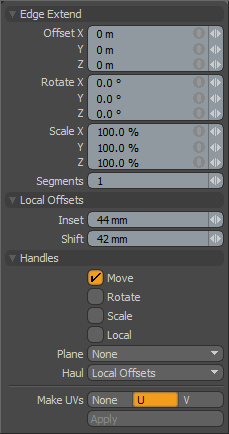Edge Extend
The Edge Extend tool provides a simple method for creating geometry from selected edges by extending them outward with options for Offsetting, Rotating, and Scaling the newly created edges. The Edge Extend tool includes a customizable tool handle. By default there are Offset and Scale handles, but these can be modified in the tools properties panel to include Rotate handles, if required. Planar Offset and Scale handles can also be assigned. This allows you to adapt the tool easily for a particular modeling operation and also means it's possible to generate more complex edge editing without dropping the tool. The Local Mode options allow you to control the extension direction for the resulting geometry based on the normal direction of the source polygon.
Usage
Prior to using the Edge Extend tool, you may want to select the target series of edges for extending (done in the Edges component mode). The Edge Extend tool is found in the Edge sub-tab of the Modeling layout toolbox. Left-clicking the button in the toolbox activates it. It can also be activated by pressing the Z keyboard shortcut. Once activated you can assign values in the tools properties panel and then press the Apply button to generate the extended edges, but to use the tool in interactive mode you need to left-click in any 3D viewport, placing the tool in interactive mode. From there, you can left-click any of the available tool handles in the viewport to interactively adjust the extension values, or numerically adjust the values in the properties panel with real-time feedback in the 3D viewport.
Left-clicking and dragging off the tool handles (hauling) defines the amount of Shift for the edge extension, with the direction determined by the Local Mode setting. While the tool is active, you can also press Shift and left-click to define a new edge extension value. When the tool is selected, the following attributes are available in the Tool Properties panel.

|
Edge Extend |
|
|---|---|
|
Offset X/Y/Z |
The Offset values determine extension distance of the newly generated edges in any of the three planar directions, or any combination thereof. These values are also adjusted interactively in the viewport while hauling (left-click and drag) when the Haul parameter is set to Global Offsets. |
|
Rotate X/Y/Z |
The Rotate values determine the amount of rotation of the newly generated edges in any of the three planar directions, or any combination thereof. |
|
ScaleX/Y/Z |
The Scale values determine the size of the newly generated edges for any of the three planar directions, or any combination thereof. |
|
Segments |
The Segments value determines the number of divisions added across the length of the extended edges. |
|
Local Offsets |
|
|
Inset/Shift |
The Inset and Shift values represent the relative local distance from the initial position of the edge (with the direction based on the adjoining polygons normal). Working much like the same Bevel options, Inset moves the extended edge parallel to the normal (left and right), while Shift moves the extension perpendicular to the normal (up and down/in and out). These values are also adjusted interactively in the viewport while hauling (left-click and drag) when the Haul parameter is set to Local Offsets. |
|
Handles |
|
|
Move/Rotate/Scale/Local |
The Move, Rotate, Scale and Local options toggle the visibility of the associated tool handles in the 3D viewport when the Extend tool is in interactive mode, allowing you to control which handles are preferred when working with edge extensions. |
|
Plane |
The Plane option allows you to further customize the tool handles by adding small planar control circles that affect two axes at once. You can choose from a Scale action for the handles or a Move action for them. None disables the extra handles. |
|
Haul |
Hauling is the action of left-clicking away from any tool handle in the 3D viewport to control an attribute. The Haul setting defines which tool attributes are affected when hauling. The Global Offset option affects the Offset X/Y/X controls of the edger extension, while Local Offsets controls the Inset/Shift values of the Local Offsets. Global offsets always move relative to the current Work Plane, local offsets are adjusted by horizontally moving the mouse cursor controlling the Inset amount, and vertically moving the cursor adjusting the Shift amount. |
|
Make UVs |
When the Make UVs option is on the U or V selection, the polygons along the extended edge have automatic UV values added along the defined axis, either the horizontal U direction or the vertical V direction. |
